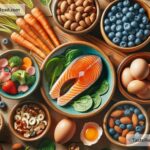Boost Your Balance: Foods that Enhance Vestibular System Function
Have you ever wondered how your body maintains balance while walking, dancing, or even standing? It’s all thanks to your vestibular system! This system, located in your inner ear, plays a critical role in helping you stay steady by sending signals to your brain about movement and spatial orientation. But did you know that food can play a part in keeping your vestibular system healthy? In this blog post, we’ll explore some essential foods that can help boost your body’s balance mechanism in simple and easy-to-understand language.
Understanding the Vestibular System
Before diving into delicious foods, let’s take a moment to understand how the vestibular system works. This complex part of your inner ear contains tiny structures like the semicircular canals and otolith organs, which detect changes in head position and movement. These structures are powered by sensory hair cells and fluid that respond to motion, sending signals to your brain. A well-functioning vestibular system keeps you grounded and prevents dizziness or vertigo.
Like all parts of your body, your vestibular system relies on proper nutrition to stay in tip-top shape. Let’s look at foods that support its health.
1. Omega-3 Fatty Acids: The Brain and Balance Boosters
Fish like salmon, sardines, and mackerel are rich in omega-3 fatty acids, which help improve brain function and promote better communication between your vestibular system and your brain. Omega-3s also improve blood flow, ensuring your inner ear structures get the nutrients they need. If you’re not a fan of fish, you can find omega-3s in walnuts, chia seeds, and flaxseeds.
Why It Helps:
Brain health is tightly linked to balance, and omega-3s reduce inflammation that could disrupt your vestibular system’s function.
Suggestions: Add salmon to your weekly dinner menu, sprinkle chia seeds into smoothies, or snack on a handful of walnuts.
2. Vitamin D for Strong Bones and Ear Health
You might associate vitamin D with strong bones, but it’s also vital for the tiny calcium-containing structures in your vestibular system called otoconia. These structures play a key role in sensing gravity and movement. Low levels of vitamin D can contribute to vertigo, a common vestibular disorder.
Why It Helps:
Vitamin D supports the health of bones, including the delicate bones within your inner ear that assist with balance.
Suggestions: Enjoy foods like egg yolks, fortified cereals, and mushrooms. Spending time in the sun can also help your body produce vitamin D naturally!
3. Antioxidants for Inner Ear Protection
Antioxidants, found in fruits and vegetables like berries, spinach, kale, and bell peppers, fight free radical damage that can harm your vestibular system over time. Free radicals are unstable molecules that can damage cells, including the sensory cells in your inner ear. By eating antioxidant-rich foods, you help protect these critical cells and keep your inner ear functioning properly.
Why It Helps:
Reducing cell damage not only protects your vestibular system but also improves overall ear and brain health.
Suggestions: Incorporate colorful fruits and vegetables like strawberries, blueberries, carrots, and leafy greens into your diet for a natural antioxidant boost.
4. Magnesium to Combat Dizziness
Magnesium is a mineral that plays an important role in nerve function and blood circulation. Research suggests that magnesium can help reduce symptoms of vestibular disorders like dizziness and vertigo. It’s also an essential nutrient for maintaining the health of your inner ear and brain.
Why It Helps:
Magnesium helps regulate healthy blood flow to the inner ear, supporting the structures responsible for balance.
Suggestions: Include magnesium-rich foods in your meals, such as almonds, avocados, bananas, and dark chocolate.
5. Hydration for Inner Ear Fluid Balance
Your vestibular system relies on fluid within its semicircular canals to detect movement. Staying hydrated is crucial to keep this fluid balanced and flowing smoothly. Dehydration can lead to issues like dizziness or poor balance, so drinking plenty of water is an easy way to support your vestibular health.
Why It Helps:
Proper fluid levels in your inner ear improve its ability to detect motion and maintain equilibrium.
Suggestions: Sip water throughout the day and eat water-rich foods like cucumbers, watermelon, and oranges.
6. Whole Grains for Steady Energy
Whole grains like quinoa, brown rice, and oats provide a steady source of energy for your body and brain. Your vestibular system works closely with your brain, meaning it needs constant fuel to function well. Whole grains also promote stable blood sugar levels, reducing the risk of dizziness caused by sugar crashes.
Why It Helps:
Healthy brain function (including balance control) benefits from consistent energy and nutrient-rich foods.
Suggestions: Start your day with oatmeal, swap white rice for brown rice, or snack on whole-grain crackers when hunger strikes.
Wrapping It Up
By eating a balanced diet packed with nourishing foods like omega-3 fatty acids, vitamin D, antioxidants, magnesium, and whole grains—and staying hydrated—you can support the health and performance of your vestibular system. These simple food choices not only enhance your inner ear function but also contribute to overall wellness.
Remember, a healthy vestibular system means better balance, fewer dizzy spells, and a stronger connection between your brain and movements. So, next time you sit down to plan your meals, pick the foods that help you stay steady and grounded. Your inner ear will thank you!
Don’t forget to consult a healthcare provider if you’re experiencing persistent dizziness or vertigo—they can help identify underlying issues and give you personalized advice.
Happy eating, and here’s to a steady, balanced life! 🌟


